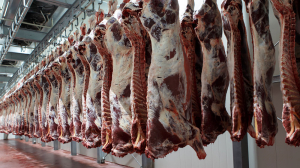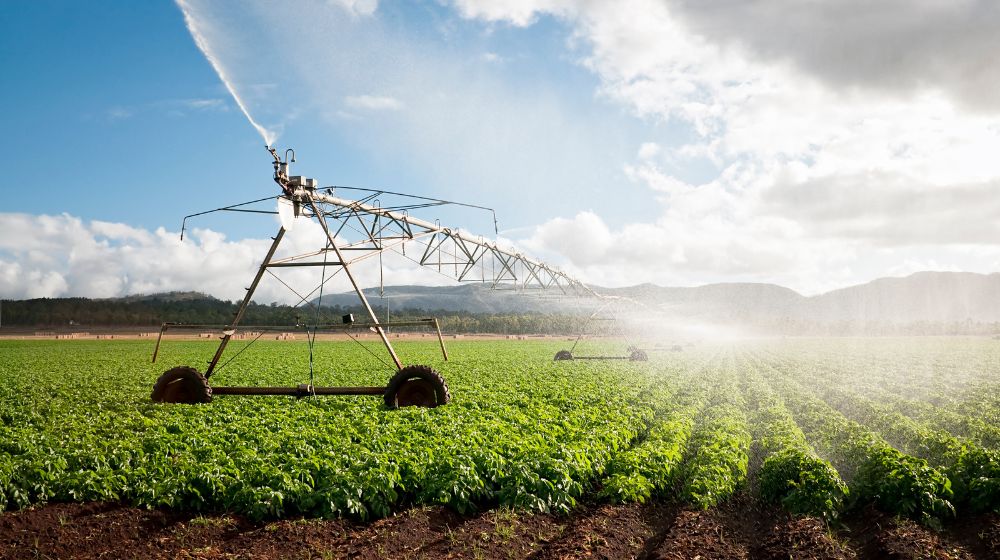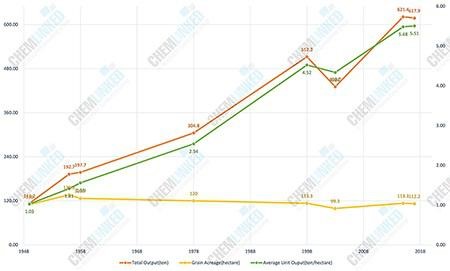


This article was written by Lin Fang, from REACH24H Consulting Group.
China is facing a number of challenges to its food security including population growth, environmental issues, urbanization and significant trade pressures. China will attempt to redress these issues through a multipronged strategy involving environmental rectification measures, relocation of cash crop regions to mountainous areas and increasing overall grain production productivity.
China’s population is estimated to peak by 2030 reaching 1.5 billion and per capita food demand will be stable at 500 kg annually. To maintain self-sufficiency in the food supply, China needs to increase grain output from 617.9 million tons in 2017 to 634 million tons by 2020 and 700 million tons by 2030. This article will take a look at the historical data on grain production and agricultural technology in recent decades. We will also look at the major challenges facing China such as environmental issues, decreased arable land and slow growth in productivity.
600% Increase in Output and Surging Food Imports
China’s grain production has undergone dramatic changes in the past few decades, increasing from 113.2 million tons in 1949 to 617.9 million ton in 2017, reaching a zenith in 2015 of 621.4 tons. Total crop area was 110 million hectares in 1949 and reached a high of 136.3 million hectares in 1956. This was followed by a steady decline from 126.7 million hectares in 1958, down to 113.3 million hectares in 1998, hitting a nadir of 99.3 million hectares in 2003 before making an appreciable recovery climbing to 113.3 in 2015.
Unit output has witnessed persistent growth from 1.03 ton per hectare in 1949 to 1.57 ton per hectare in 1958 and 5.48 ton per hectare in 2015 and recording a new high of 5.51 ton per hectare in 2017.

Figure 1-China’s Historical Changes in Grain Output, Cultivated area and Unit Output
Staged Driving Forces
Implementation of state of the art agricultural technology has allowed China to maintain sustainable growth with limited arable land over the past decades. Crop and irrigation area and uses of chemical and traditional organic fertilizers have been continuously expanded and farmland reclamation and agricultural mechanization have also been heavily promoted.
Rigorous Challenges
Although China has made considerable efforts to boost grain production, the balance of food trade has tipped towards deficit with annual imports reaching 100 million tons in the 2010s. This situation is worsening as China continues to urbanize and industrialize: China’s per capita water availability is only 25% of the worldwide average. 65% of water goes to agriculture. Traditional domestic grain supply-demand relationships have changed in recent years from South-to-North to North-to-South. (Historically, South China used to be the main grain plantation area and northern regions were the primary destination). Over the past 10 years, water shortages have also worsened and become a serious threat. Total farmland has decreased from 139.3 million hectares to 121.4 million hectares currently of which 20% has been seriously polluted, combined with degradation and desertification. As a result crop area has decreased by as much as 66.6 million hectares every 20 years since 1958. It is estimated that China’s crop area will drop to 106.7 million hectares in 2020 and 100 million hectares in 2030 As unit output growth has gradually slowed in recent decades, grain plantation has become unattractive to Chinese farmers, who shifted from grain toward cash crops, poultry farming or other livelihoods. This change is more widespread in southern regions, which is the primary reason behind the reversal in the traditional supply-demand relationship between the south and the north.
Quantitative Indicators in Food Security
Think tanks and experts have brought forward several suggestions on the new strategy in national food security including: Food security should be absolutely secured with high self-sufficiency in grains. Current cropping structure can be further optimized by increasing cereal plantation in high-yield areas and moving cash crop and factory farms to mountainous regions; China need to keep a minimum of 121.3 million hectare of farmland by 2020 and a minimum of 120.0 million hectare in 2030. In consideration of soil pollution treatment, ecological restoration, field fallow and forage plantation, China can reduce grain crop area to 108.6 million hectare by 2020 and 105.3 million hectare by 2030; Irrigation water will be reduced to a minimum of 360 billion ton per year; China committed to a specific grain importation quota with the WTO which will be subject to a low duty tariff rate (importation outside the quota will subject to higher tariff). Rice, wheat and maize accounted for 5.32 million tonnes, 9.64 million tons and 7.2 million tons of the quotas in 2018; China’s maize importation will account for about one third of global maize trade in the future. China will individualize importation procedures and regulations depending on their degree of self-sufficiency. Imported grains will be divided into 4 categories.
The original version of this article was published on 30 May 2018 at ChemLinked.com.